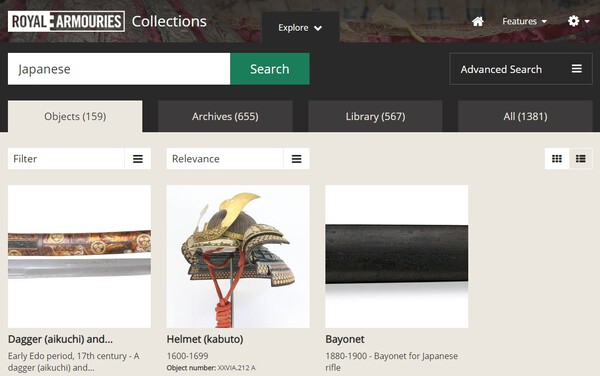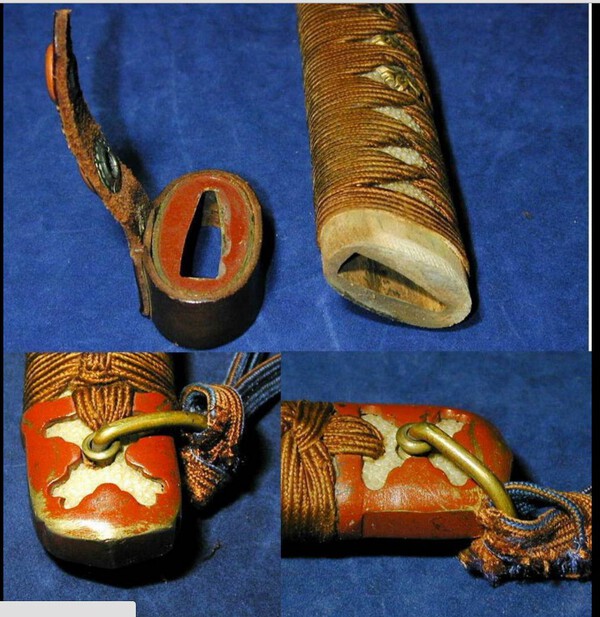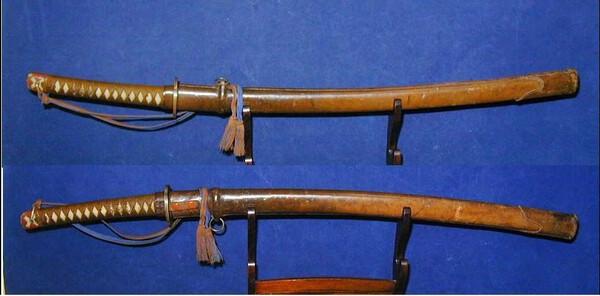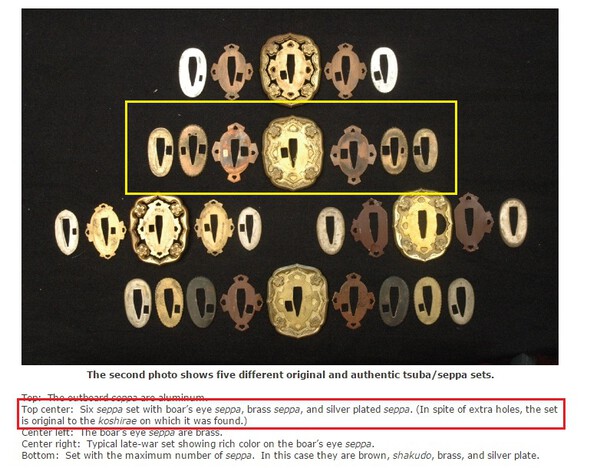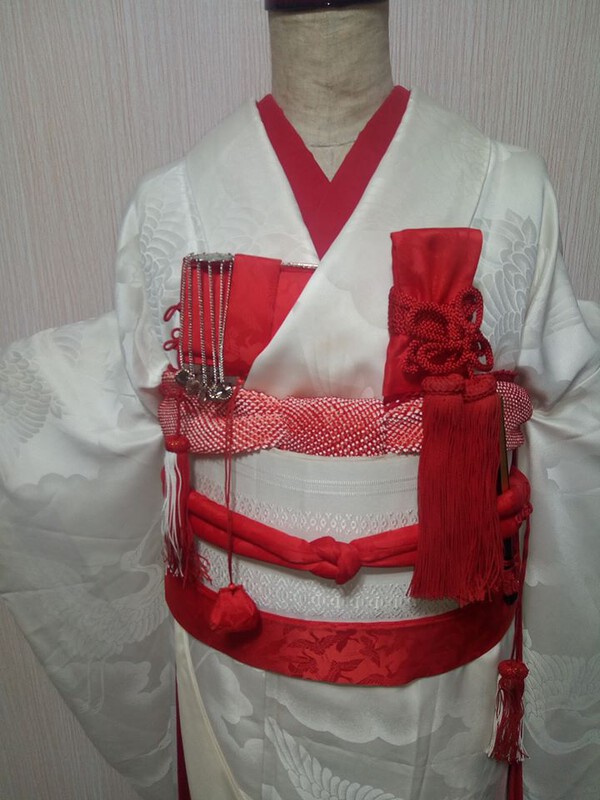-
Posts
1,690 -
Joined
-
Last visited
-
Days Won
11
Everything posted by Dave R
-
Looking odd, and looking interesting. We are now doing down the learning curve helter skelter.
-
From the photo's posted, you have a perfectly decent later war Officers Shin Gunto. The Ito has bust which is a pity but not a tragedy, and explains why it has shifted to hide the Mekugi-ana. The fastenings on these vary a lot, so careful investigation is needed. The stamp is the "Sho" stamp which means that it was judged to be non traditional in some way, a term which covers a lot of ground. I think you did OK, would you be up for posting the vendors pics so we can see the difference? Meanwhile have a look here to see some of the variations possible. This is an old site, so some of the terms and information is considered to be a bit out of date, but still well worth a look. http://ohmura-study.net/952.html
-

How to safely unstick shirasaya?
Dave R replied to Brano's topic in General Nihonto Related Discussion
The glue dissolves in water, I do it with shirasay and koshirae all the time when repairing and refitting. Rice glue is in theory weaker than the wood, but in practice I have found that to not be always the case. You do have to watch for warpage, so I split the piece after a soak, dry with tissue and clean all the glue away.. and then bind with a strip of cloth and leave it for a matter of days. Your problem may just be swelling due to the moist glue, so frankly I would hang on for a few days and see if that makes a difference.... (There is always a possibility that it never fitted, and that's why it bust) -
Link to the Royal Armouries online collection. Not everything has photo's, but still well worth a peruse...... https://collections.royalarmouries.org/#/objects?search=Japanese&sort=relevance
- 5 replies
-
- 10
-

-
Is it just me, or is that a very "chippy" signature?
-

UNUSUAL DAGGER - MADE IN Japan FOR CHINA?
Dave R replied to Bazza's topic in Military Swords of Japan
Question, if it's such uninteresting crap (and we have established that it's not a genuine piece) why go to the effort of commenting? -
With this one the tassel arrived as part of the whole package, with age appropriate wear. Vendors photo's 'cos they are better than any I could currently take. The koshirae is a very plain, and a field saya so probably later war.
-

Fun Topic: The Unusual: Blades, etc.
Dave R replied to barnejp's topic in General Nihonto Related Discussion
It is a cracker, and if you are ever in the UK, well worth a look.... As is the rest of the Japanese collection in the Leeds RA. -

Any information on this sword!
Dave R replied to claymoats's topic in General Nihonto Related Discussion
I buy from Namikawa a fair bit, and got my Uchiko from them, but have no intention of using it on a blade in polish..... but not every blade is in polish! There is that state, where you need to do a serious clean to see if it's worth going any further. One thing about using Uchiko on an out of polish blade, is that you are doing nothing to it that was not done to it before. I have also seen people recommend Tsunogo, which can also be bought from Namikawa... who also accept Paypal! https://www.namikawa-ltd.com/product/72 -

Any information on this sword!
Dave R replied to claymoats's topic in General Nihonto Related Discussion
Regarding the nakago, as with everything else there are different opinions on oiling and not oiling. Traditionally the nakago is is not oiled, but as has been pointed out, times change and we no longer use these pieces in combat. NB, the author of the below article is highly respected in the Nihonto community. Oil your nakago – The Cutting Edge -

UNUSUAL DAGGER - MADE IN Japan FOR CHINA?
Dave R replied to Bazza's topic in Military Swords of Japan
On collectors forums for other ethnic weapons and militaria weird stuff turns up all the time! A decent amount of it often turns out to be tourist stuff. Sometimes it turns out, as with a lot of African stuff, that the original makers made no differentiation, and a tourist bought an authentic piece, and sometimes also with African stuff it's complete Brumagem in the truest sense of the word.... In one case it turned out to be a fantasy art piece made by a well known artist. All good fun, and a learning experience for all of us. On balance I think it's a tourist piece as well, made for those with too little capacity for a full sword... those ruddy CB's and Aussies! -

UNUSUAL DAGGER - MADE IN Japan FOR CHINA?
Dave R replied to Bazza's topic in Military Swords of Japan
If you never look at or discuss the unusual or different, you are severely limiting yourself. There have been some surprises on this site and on others. Just because it does not conform does not mean it's wrong. I have no idea as to the origin of this piece, but if another one turns up we will know that it is probably a production run rather than a one off. It's not as if it costs us money! -

Any information on this sword!
Dave R replied to claymoats's topic in General Nihonto Related Discussion
Things that can be told, it's in a shirasaya (storage mount) and that coupled with the engraved habaki tells us that someone valued the blade. The nakago aka tang is signed and has a fair build up of patina, indicating that it is of some age. Things that can be done, clean the grease of the blade, and remove the habaki for the next photo's. Do not use abrasives on any part of it at all. Post photos of the writing on the tang blade up in the way that page one of this site tells you! To take a clearer picture of the signature try dusting it with talcum powder. Take close up pictures og the point of the blade, and of the area covered by the habaki. -

UNUSUAL DAGGER - MADE IN Japan FOR CHINA?
Dave R replied to Bazza's topic in Military Swords of Japan
This and the tagged post have me thinking, did the IJA or IJN at any time issue a brush knife, fascine knife or machete? -
Apparently they could be given as a wedding present even.
-
If you have a nice even curve, and all the parts are tight, then I would (with usual disclaimers) say that you have a decent legit' sword. We know that they did field repairs, and were more concerned with function than art.
-
A "bitser" but when was it done and to what extent? It could even be one that started life as all together, but then had extra or replacement seppa as wood and leather shrank. You say the main pieces fit well, have you had a look, end on to see if the total overall curve is even from one end to the other....
-
Whatever it was originally, doesn't matter any more. For me the "flag" was the abandoned polish, which means that something was discovered during the process that made further effort worthless. Deep pits, hagire whatever. The vendor was dumping an abandoned project.
-
You might find this interesting, these blades could be won as part of a women's bridal outfit! In this case neatly tucked away in a special bag.
-

Oldest piece of Japanese art
Dave R replied to kissakai's topic in General Nihonto Related Discussion
Hard to confidently date stuff like that without papers! -

Is there a blue book of sort for pricing WWII pieces
Dave R replied to MarcoUdin's topic in Military Swords of Japan
A good use of your lock-down time is to work your way through this section of the NMB, and have a thorough peruse of this site linked below. It's not "the last word" but it is a good primer...... http://ohmura-study.net/900.html -

1940 Kamenichi Officer’s Sword. Symbol meaning?
Dave R replied to Rmueller9's topic in Military Swords of Japan
I am always wary of judgement calls based on photo's, if possible get it to someone who can see it in hand. (Yeah, I know we are in lockdown so it will be a while). The mounts are good quality, so I would guess that the blade is at a higher end as well. -
Regarding the nakago, I wonder if it has had a signature removed?
-

1940 Kamenichi Officer’s Sword. Symbol meaning?
Dave R replied to Rmueller9's topic in Military Swords of Japan
There is a fair amount of back and forth on the "exact" meaning and origin of the marks, with Mr Ohmura giving one story, and Mr Komiya another. But from what I can gather, the Sho(wa) stamp was ordained at the national government level so that a non-Nihonto could not be passed off as one. The Seki stamp was ordained by the city of Seki to mark a blade as being made there and having passed their quality tests, very like the way Sheffield and Solingen mark their products. -

1940 Kamenichi Officer’s Sword. Symbol meaning?
Dave R replied to Rmueller9's topic in Military Swords of Japan
"Sho" means that it it did not fulfil a rigid set of specifications to be judged as traditional. I would pull back a bit on calling it mass produced, which is how the NCO blades were made. More likely made in a small workshop, possibly a decent sized factory, but still involving a lot of skilled handwork.


